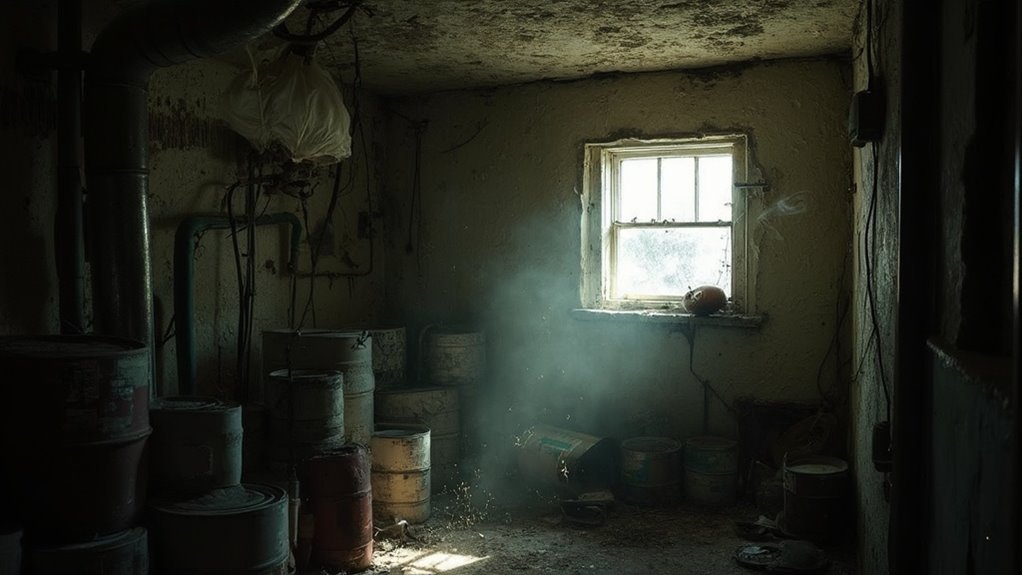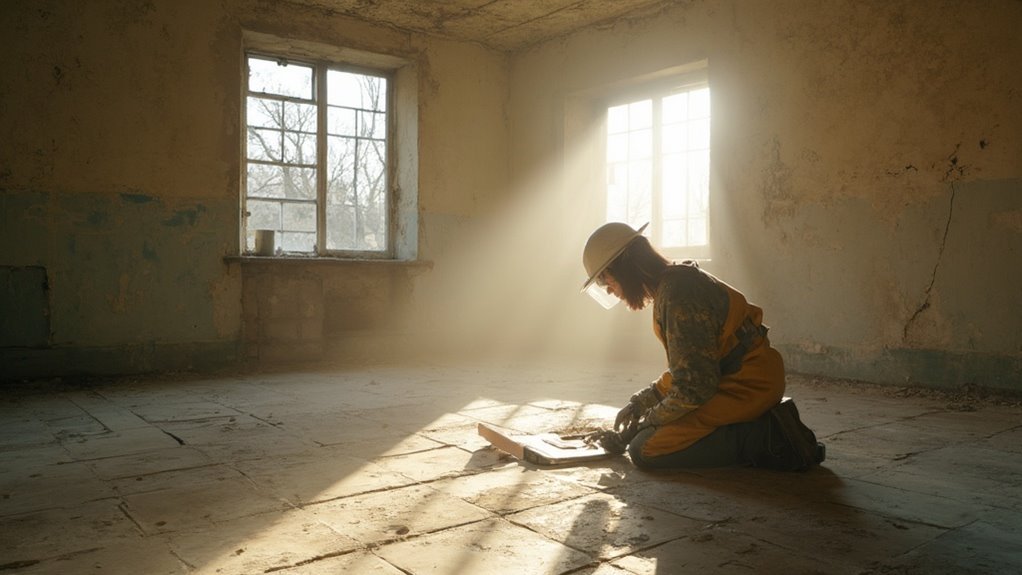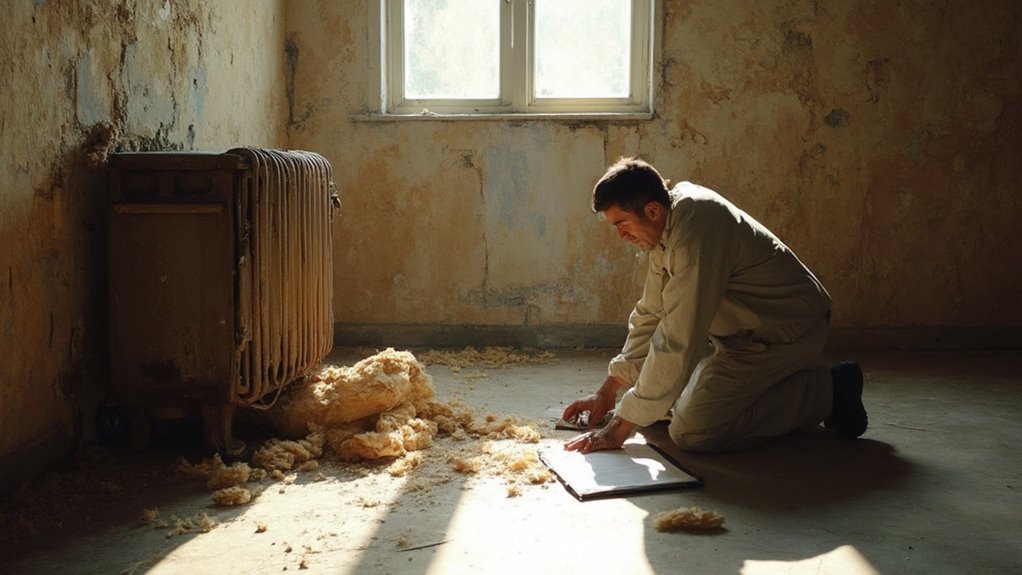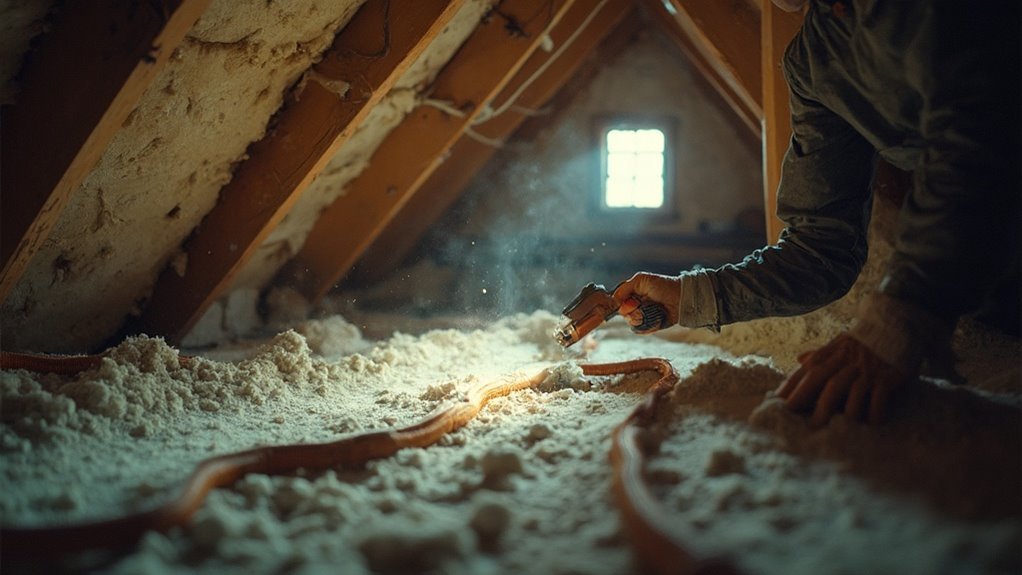To spot asbestos in your home, start by evaluating for certain materials, especially if your home was built before 1980. Look for 9×9 or 12×12 vinyl floor tiles, textured ceiling tiles, and insulation in attics or walls. An inspection is critical; it minimizes health risks and helps you comply with safety regulations. Hire a certified professional who will conduct visual examinations and collect samples using safe procedures. They'll provide detailed reports and guidance on managing asbestos. Understanding these steps is important for your safety and property value, and there's more you can investigate about this key topic ahead.
Identifying Asbestos-Containing Materials

When you're evaluating your home for potential asbestos-containing materials, it's essential to know where to look and what to identify. Start by examining the exterior, focusing on materials like asbestos siding. Look for fibrous cement siding with a dimpled pattern, which often indicates the presence of asbestos. If your home was built before 1980, it is vital to inspect the roofing shingles, as they may also contain asbestos.
Inside, check the floor tiles, particularly the 9×9 inch vinyl tiles, as these are notorious for asbestos content. Ceiling tiles and textured popcorn ceilings are common sources as well, often hiding asbestos fibers within their composition. Pay attention to the insulation in your attic and walls, especially if it's vermiculite insulation, which has a high likelihood of containing asbestos. Moreover, asbestos exposure can lead to serious health risks, making it crucial to identify and manage these materials effectively. The commitment to safety by professionals also plays a vital role in ensuring a safe environment during inspection and removal processes.
Visual indicators, like corrugated paper wrap around pipes or white and gray papery coverings, can additionally suggest asbestos presence. For accurate fiber identification, remember that professional testing is the most reliable method to confirm asbestos. By knowing what to look for, you can take the necessary steps to guarantee your home's safety.
Reasons for Conducting Inspections
Conducting inspections for asbestos is crucial for maintaining a safe living environment. Asbestos exposure can lead to severe health risks, including lung cancer and mesothelioma. Regular inspections guarantee you identify and manage hazardous materials before renovation or demolition, safeguarding your health and complying with legal responsibilities.
Here's a summary of critical reasons for conducting inspections:
| Reason | Importance |
|---|---|
| Safeguarding Safety | Protects against health risks associated with exposure. |
| Preventing Unexpected Costs | Avoids costly delays and remediation expenses. |
| Legal Compliance | Meets OSHA and EPA regulations, mitigating legal risks. |
| Environmental Liability | Reduces potential liabilities from asbestos-related issues. |
| Health Risks and Precautions | Establishes necessary containment and removal protocols. |
The Inspection Process

Inspecting for asbestos requires careful planning and execution to guarantee safety and compliance throughout the process. Start by scheduling a professional inspection with a certified expert who understands inspection protocols. Clear access to all areas of your home, including attics and basements, is critical. Remove personal items in potential sampling zones to enable a thorough examination.
During the inspection, the professional will conduct an initial assessment, reviewing historical data and inspecting accessible areas for probable asbestos-containing materials. A detailed visual inspection follows, where they'll examine building materials for damage or degradation. Sampling procedures involve the wet method, minimizing fiber release, before collecting small sections for analysis. Safety equipment, including personal protective equipment (PPE), is necessary throughout this process.
Containment strategies, such as laying plastic sheeting and employing negative air pressure machines, help prevent fiber dispersion. After gathering samples, they'll be sent to accredited laboratories for analysis. Finally, review the results to determine the extent of asbestos presence and plan for necessary containment or removal, ensuring compliance with regulations and occupant safety. This methodical approach is important for effectively managing asbestos risks in your home.
Importance of Professional Help
Managing the complexities of asbestos identification in your home demands professional expertise, as the risks associated with improper handling can be severe. The certification importance cannot be overstated; trained and certified inspectors possess the skills needed to accurately identify and assess asbestos risks. They conduct thorough analyses, utilizing laboratory tests to confirm the presence of asbestos, guaranteeing nothing is overlooked.
Safety protocols are a priority for these professionals. Equipped with specialized tools and knowledge, they mitigate exposure risks during inspections. By relying on experts, you avoid the health hazards posed by DIY attempts, which may lead to improper detection or the dangerous spread of asbestos fibers.
Additionally, professional inspections yield detailed reports that document the presence, location, and condition of asbestos. This documentation is vital for legal compliance and real estate transactions, providing you with the necessary protection and peace of mind. Essentially, engaging a certified professional not only guarantees accurate identification but also guides you on safe management or removal options, ultimately safeguarding your health and property.
Costs of Asbestos Inspections

Asbestos inspection costs typically range from $200 to over $1,000, depending on various factors that influence the final price. For a typical residential inspection, you can expect costs between $225 and $600. If you're considering airborne asbestos testing, be prepared for expenses that can run from $500 to $1,000 or more. Cost variability is largely determined by the type of test, the number of samples taken, the size of the area inspected, and the laboratory fees involved.
In urban areas, pricing tends to be higher because of increased demand and operational costs. Simplified tests like air clearance are usually less expensive than more complex bulk sample analyses. Additionally, larger areas may necessitate more samples, which naturally increases your overall expenses.
If you combine asbestos testing with a general home inspection, you might save money, as the average home inspection costs around $330, plus a smaller additional fee for the asbestos assessment. Keep in mind that qualified inspectors often charge more, but their expertise can be invaluable in ensuring accurate results.
Follow-Up Actions After Inspection
After an asbestos inspection, it's crucial to take systematic follow-up actions to guarantee safety and compliance. Begin by documenting the inspection findings, including the location, condition, and type of asbestos-containing materials. Record sampling results, air monitoring data, and prepare thorough inspection reports that include risk assessment recommendations.
Next, evaluate the risk of asbestos exposure based on the condition and location of the identified materials. Identify high-risk areas likely to be disturbed and develop control measures to mitigate exposure, prioritizing corrective actions accordingly. Implement safety protocols to minimize risks during any subsequent handling of asbestos.
For more extensive situations, develop detailed abatement planning, verifying all methods, timelines, and safety protocols are clearly outlined. Hire certified contractors for execution, seal off work areas to prevent fiber spread, and conduct air monitoring to comply with exposure limits during abatement.
Finally, establish ongoing monitoring and maintenance by scheduling regular inspections, updating management plans in response to building conditions, and providing training for employees on asbestos awareness. Maintain thorough records of all inspections, sampling, and abatement activities to comply with regulatory requirements.
Safety Tips for Homeowners

To guarantee a safe environment, start by identifying potential asbestos-containing materials in your home, such as insulation or floor tiles. Plan for professional inspections to assess the situation accurately, as this guarantees thorough evaluation and mitigates risks. Always hire certified professionals for any asbestos-related work, as their expertise is vital in handling hazardous materials safely and efficiently.
Identify Potential Materials
When inspecting your home for potential asbestos-containing materials, focus on specific areas and materials where asbestos was commonly used. Understanding these materials is essential for effective asbestos testing and fiber identification.
| Material Type | Common Locations |
|---|---|
| Floor Tiles | Vinyl tiles (9×9 inches) |
| Ceiling Tiles | Textured and popcorn ceilings |
| Shingles and Siding | Older roofing materials |
| Insulation | Attic and wall insulation |
| Pipes | Pipe insulation and wraps |
Inspect your flooring for vinyl asbestos tiles, especially those measuring 9×9 inches or 12×12 inches. Check ceilings for textured surfaces, which may contain asbestos. Be cautious with older shingles and siding materials; these often include asbestos for added durability. Moreover, inspect insulation found in attics and walls, particularly vermiculite insulation, as it can harbor asbestos fibers.
For pipes, look for any insulation or heat-resistant fabrics that appear fibrous or frayed. By pinpointing these materials, you can better assess the risk in your home and take appropriate safety measures before proceeding with inspections.
Plan for Inspections
Identifying potential asbestos-containing materials in your home is just the first step; planning for inspections is as essential to guarantee safety and accuracy during the process. Start with a preparation checklist to guide your actions. Clear personal items from inspection areas to ease sample collection and make certain of easy access to attics, basements, and crawl spaces. If materials may be disturbed, implement containment protocols to prevent the spread of asbestos fibers.
Turn off HVAC systems to avoid circulating airborne particles. Inform all household members about the inspection and establish safety measures, making sure children and pets stay away from inspection zones. In some cases, vacating the property may be advisable.
During the inspection, avoid disturbing any suspected asbestos materials. The inspector will conduct a thorough visual assessment, collect samples, and utilize specialized equipment to inspect hard-to-reach areas. Follow any guidance regarding containment measures provided by the inspection team.
Post-inspection, review test results carefully, and manage any identified asbestos responsibly. Maintain awareness of the locations of asbestos-containing materials and monitor for damage. Proper planning and adherence to safety protocols are critical for safeguarding your home and family.
Hire Professionals Only
Hiring professionals for asbestos inspection and removal is essential for guaranteeing safety and compliance with regulations. Only certified experts can accurately identify and manage asbestos-containing materials (ACMs) in your home. They follow strict guidelines, which not only protects your family but also guarantees regulatory compliance.
Here's a concise overview of the key aspects of hiring professionals:
| Aspect | Importance |
|---|---|
| Certified Professionals | Guarantee expertise in handling ACMs |
| Personal Protective Equipment (PPE) | Protects against exposure |
| Laboratory Analysis | Confirms presence of asbestos |
| Detailed Inspection Reports | Provides clear findings and recommendations |
When selecting professionals, inquire about their insurance coverage. This safeguards you from potential liabilities during the inspection or removal process. Avoiding DIY approaches is vital; even minor disturbances can release hazardous fibers into your environment. By hiring trained specialists, you mitigate risks and guarantee that any asbestos abatement follows industry standards.
Frequently Asked Questions
How Can I Tell if My Home Was Built With Asbestos Materials?
To determine if your home's built with asbestos materials, check for asbestos signs in older materials, especially insulation, flooring, or siding. If your house dates back to before 1980, consider professional testing for safety.
What Symptoms Indicate Possible Asbestos Exposure?
If you're feeling like a storm brews within your lungs, watch for respiratory issues and chronic coughing. These symptoms might signal asbestos exposure, urging you to seek medical advice and further evaluation. Stay vigilant.
Are There Any DIY Methods for Asbestos Testing?
You can use DIY sampling methods to collect materials suspected of containing asbestos. After gathering samples, follow the instructions for laboratory submission to guarantee accurate analysis, but be cautious of potential inaccuracies and safety risks involved.
How Long Does an Asbestos Inspection Typically Take?
Inspection duration varies substantially based on the site's size and access. Smaller projects might take a couple of hours, while larger, complex sites can require several days to guarantee thorough assessment and safety compliance.
What Should I Do if I Suspect Asbestos in My Home?
If you suspect asbestos in your home, prioritize safety protocols. Hire a certified inspector to assess potential hazards and collect samples, ensuring they follow proper regulations. Don't attempt to handle suspected materials on your own.
